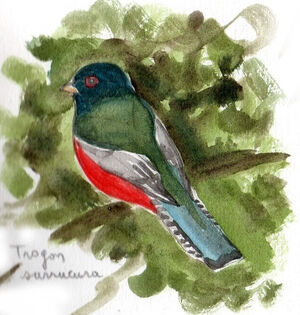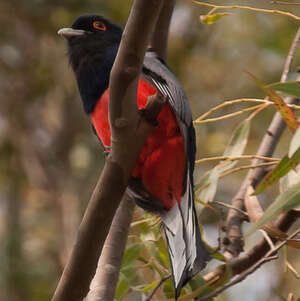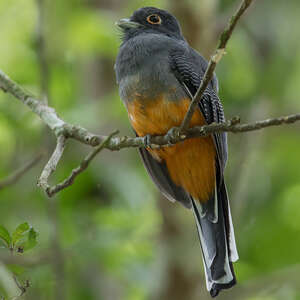Surucua Trogon
Trogon surrucura - Trogon surucua
Identification
Surucua Trogon may (hypothetically speaking!)find the origin of its scientific and Latin name in the Hispanias prefix sur which specifies its presence in the south and the Latin verb occurrere which possible Latin translation is encounter. Thus, our Surucua Trogon would be the one that is encountered in the south; Louis Jean Pierre Vieillot, the French ornithologist (1749-1831) was not mistaken, since there are no trogonidae existing farther south in South America! Many scientists think that Surucua Trogon forms a super-species with White tailed Trogon, Baird's Trogon, Citron Trogon, and Black headed Trogon. As is the case with all trogons, dimorphism is quite evident; measuring at 26 cm, the male has a black head, throat, and paratides, an orange orbital circle surrounding the dark brown iris that stands out immediately. The light grey-green beak is a feature that sets it apart from its sometimes shared territory cousin - the Racket tailed Trogon. The chest is an ultramarine blue with purple glints at the junction of the chest and abdomen, fading into a nearly black deep turquoise blue. The crown and the nape are the same blue as the chest, turning into a green-emerald or a coppery green on the mantle and back, and again "bluing" into a dark turquoise blue on the upperside feathers. The scapulars are green-emerald with a golden sheen, while the small and large coverts are fine horizontals of black and white vermiculation, and the primary feathers and alula are black, finished off with a strong white edging. The undersides of Surucua Trogon's rectrices are white, finished off with a black line at the tip - an easy identification feature to differentiate it from its cousin the Racket tailed Trogon, which has horizontal black stripes on the underside rectrices.The upper rectrices are dark turquoise blue with a distinct black line at the end of the tail. The tarsi are brown-gray. Her mate is less contrasting and displays different shades of gray. The head is gray, the parotic feathers are dark gray around a brown iris eye. The Surucua Trogon female is made up of two half circles of white in front and back of the eye, the beak is gray. The gray chest lightens to gray in the lower part and on the sides, the abdomen is a lighter red than her companion, almost pink. The mantle and back are gray, the black coverts are chiseled with rather wide horizontal white lines that can be seen from afar, the alula and primary coverts are extended with anthracite primary and secondary remiges outlined with a white line on the edges. The lady completes her outfit with three pairs of lower rectrices white marked in the center with downward-facing anthracite points, the end of the tail ending with a horizontal black line; the upper rectrices remain gray and end with the same black horizontal line. Juveniles keep their mother's plumage, young males begin to take their first reflections of green on the mantle and back, the abdomen is pinker than bright red and the lower rectrices are black and white and not yet the whiteness of their father. Two subspecies are recognized, ssp surrucura surrucura previously described mainly located inland and ssp surrucura aurantius along the Atlantic Coast, the male has an orange abdomen, the head and chest are violet rather than ultramarine blue, the mantle and back tending to blue, the orbital circle is yellow instead of orange, the female has the top of the abdomen yellow and the lower abdomen yellow-orange, the orbital circle is the same yellow as the male.
Subspecific information 2 subspecies
- Trogon surrucura surrucura (Paraguay, s Brazil, Uruguay and n Argentina)
- Trogon surrucura aurantius (e Brazil)
Foreign names
- Trogon surucua,
- Trogón surucuá meridional,
- surucuá-variado,
- Surucuátrogon,
- surucua trogon,
- Surucuátrogon,
- Trogone surucua,
- surucuatrogon,
- Surucuatrogon,
- trogón surukura,
- trogon surukura,
- Surucuatrogon,
- liusketrogoni,
- trogon surucuà meridional,
- trogon czerwonobrzuchy,
- Трогон-суруку,
- オジロキヌバネドリ,
- 苏鲁美洲咬鹃,
- surucuatrogon,
- 蘇魯考美洲咬鵑,
Voice song and call
His song resembles a qwiow-qwiow-qwiow repeated 15 to 20 times with a very high pitch and ending in a cuii-cuii which decreases intensity. The male also produces a creaky sound like that of a rattle, qwoaa-qwoaa rolling without interruption, to call the females during the breeding season.
Habitat
Behaviour character trait
Dietfeeding habits
Reproduction nesting
The Surucua Trogon breeds from September to December in southeastern Brazil and August in Argentina. The pair builds the nest in old tree trunks, arboreal termite mounds, tall tree fern trunks, and even large cacti! The clutch typically consists of two to three eggs, but unfortunately there is no information available on incubation and feeding periods for the chicks.
Geographic range
South of Latin America, Surucua Trogon can be found in Argentina, particularly in the Iguaçu Reserve; there have been numerous observations in Uruguay, east of Paraguay, and of course in Brazil, mainly in the state of Rio Grande do Sul and Minas Gerais. Subspecies aurantius, confined to the Atlantic Coast of Brazil, is probably hybridizing with subspecies surrucura.
Threats - protection
IUCN conservation status
concern
in the Wild
threatened
evaluated
Le Trogon surucua lC. ne semble pas être en danger à l'heure actuelle, son aire de distribution étant assez large et les grands parcs naturels visant à le protéger, son avenir dépend maintenant de la volonté humaine !
Sources of information
- IOC World Bird List (v15.1), Gill, F and D Donsker (Eds). 2025-12-07.
- A Natural history of the Trogonidae, Joseph M.Forshaw Albert Earl Gilbert
- Vol. 6 - Handbook of the Birds of the World, Josep del Hoyo-Andrew Elliott-Jordi Sargatal
- A Field Guide to the Birds of Brazil, Ber Van Perlo
- xeno-canto, Sharing bird sounds from around the world,
- BirdLife International, BirdLife International
- Avibase, Lepage Denis
- Wikipédia, Wikipedia, The Free Encyclopedia
- Planet of Birds,
- Neotropical Birds Online,
Other sources of interest
 Specification sheet created on
03/08/2023 by Anne et Gabriel Leboff
Specification sheet created on
03/08/2023 by Anne et Gabriel LeboffTranslation by AI Oiseaux.net
© 1996-2025 Oiseaux.net
- Accipitriformes
- Aegotheliformes
- Anseriformes
- Apodiformes
- Apterygiformes
- Bucerotiformes
- Caprimulgiformes
- Cariamiformes
- Casuariiformes
- Charadriiformes
- Ciconiiformes
- Coliiformes
- Columbiformes
- Coraciiformes
- Cuculiformes
- Eurypygiformes
- Falconiformes
- Galliformes
- Gaviiformes
- Gruiformes
- Leptosomiformes
- Mesitornithiformes
- Musophagiformes
- Nyctibiiformes
- Opisthocomiformes
- Otidiformes
- Passeriformes
- Pelecaniformes
- Phaethontiformes
- Phoenicopteriformes
- Piciformes
- Podargiformes
- Podicipediformes
- Procellariiformes
- Psittaciformes
- Pterocliformes
- Rheiformes
- Sphenisciformes
- Steatornithiformes
- Strigiformes
- Struthioniformes
- Suliformes
- Tinamiformes
- Trogoniformes




























